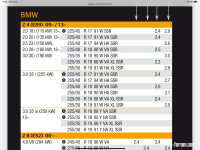Just changed the 4 Bridgestone Potenza run flat tyres on my 2016 E89 Z4 to 4 Michelin Primacy non
runflats.
The technician was not sure of the tyre pressures but put 36 in each wheel (car has 17 inch alloys)
Can anyone advise me of the correct pressures to use
Thank you
runflats.
The technician was not sure of the tyre pressures but put 36 in each wheel (car has 17 inch alloys)
Can anyone advise me of the correct pressures to use
Thank you
